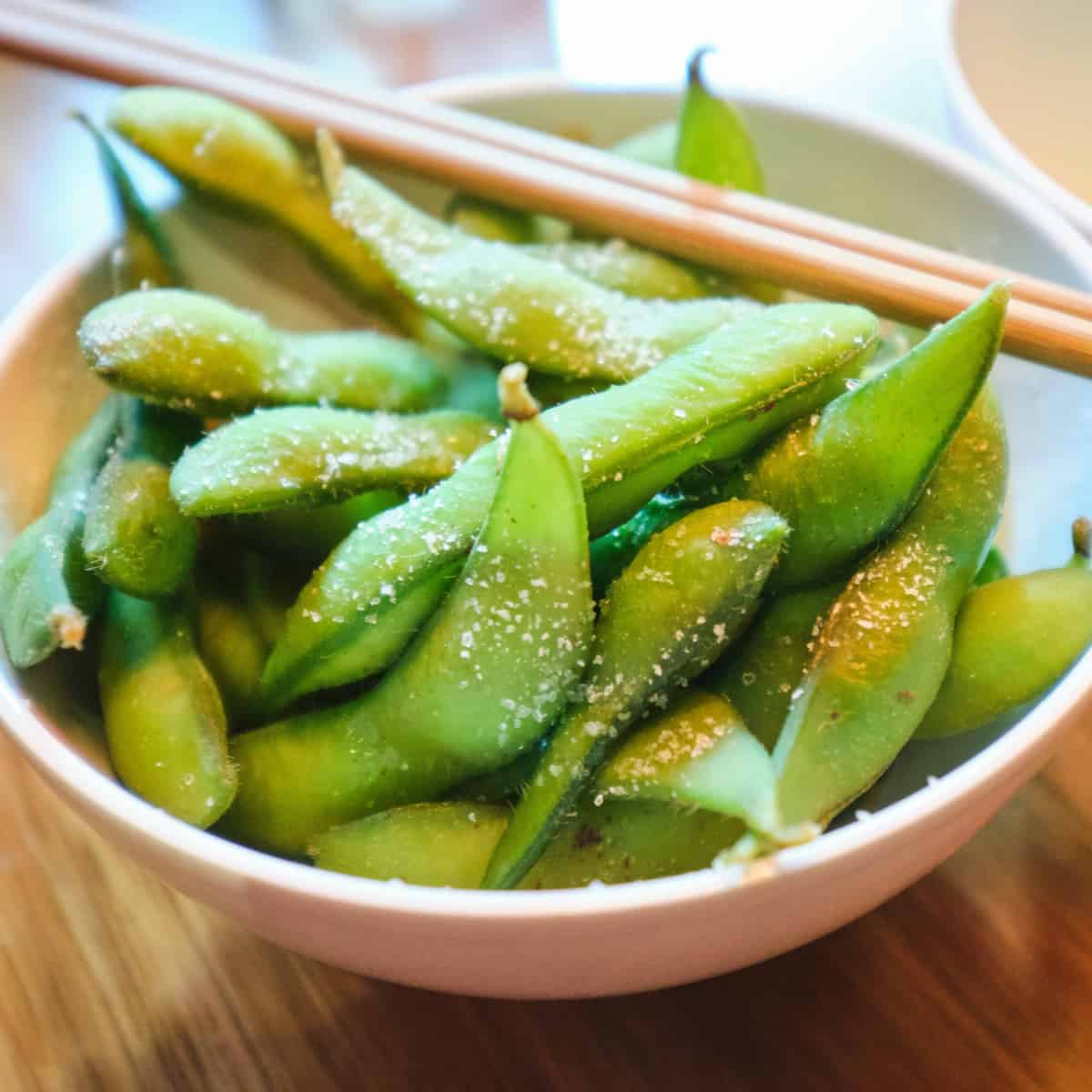In recent years, edamame beans have become a staple in many households, and for good reason. Edamame is a plant-based protein that is packed with nutrients. The tasty, nutty flavor makes them a perfect snack. The importance of knowing how to reheat edamame becomes an important skill for those seeking to enjoy its goodness at its best. Whether for quick snacks, creative recipes, or as a side dish, understanding how to reheat edamame is key to preserving its texture and flavor.

Jump To
In this comprehensive guide, I'll explore the best ways to prepare, store, and enjoy edamame, including different cooking methods and tips for making the most of these humble beans.
What is edamame?
Edamame refers to young, green soybeans that are harvested before they ripen or harden. The term "edamame" is Japanese and translates to "stem bean" or "twig bean." Edamame is a popular and nutritious snack in many parts of the world. The beans inside the pods are bright green and have a slightly sweet and nutty flavor. When eating edamame, the pods are usually popped open to release the beans, which are then eaten directly. It has become increasingly popular as a healthy and nutritious food option, and you can find it in various forms, including fresh or frozen in grocery stores.
Edamame is often included on restaurant menus due to its popularity as a snack. Edamame is often served in its pods, making it a visually appealing and interactive dish. The act of popping the beans out of the pods can be a fun and engaging experience, especially when shared among diners.
The basics of reheating edamame
The importance of selecting the right reheating method cannot be overstated, as it directly impacts the overall enjoyment of this nutritious snack. Each method, from microwaving to steaming and air frying, presents a unique approach, allowing individuals to tailor their choices based on personal preferences. Whether one seeks a quick fix or prefers a method that imparts specific textures or flavors, the reheating technique plays a pivotal role in ensuring the edamame experience remains delightful and satisfying.
Different reheating methods
Steaming method
When it comes to preserving the freshness of edamame, steaming is an excellent method. This gentler approach helps prevent the edamame from becoming mushy or overcooked, which can easily happen with more aggressive reheating methods. Steaming also helps preserve the vibrant green color and fresh flavor of edamame.
Here are some simple steps when you choose to reheat edamame by steaming:
Arrange the unshelled edamame in a steamer basket over a large pot of boiling water for 3-5 minutes. The exact time may vary based on whether the edamame is fresh or frozen. The edamame should be heated through but still have a slight firmness to the bite. Overcooking can lead to a loss of texture. Once the edamame is reheated, add your preferred seasonings, such as sea salt or soy sauce, to enhance the flavor.
Microwave method
For those seeking the easiest way to enjoy edamame, the microwave is a game-changer. The microwave method is not only time-efficient but also a great option for busy individuals looking for a convenient and tasty snack.
Here are step-by-step instructions for the microwave reheating method:
1. Arrange the edamame in a single layer in a microwave-safe bowl. For added moisture, you can sprinkle a small amount of water over the edamame. This can help prevent the beans from drying out during the microwave reheating process. This step is optional.
2. Cover the dish with a microwave-safe lid or a microwave-safe plate to trap steam. If you don't have a cover, you can use a microwave-safe damp paper towel.
3. Start with a conservative reheating time, such as 1 minute, especially if the edamame is already partially cooked or thawed. Check the cooked beans' texture after each minute to avoid overcooking. If the edamame is frozen, it may take longer. Begin with 2-3 minutes and adjust as needed.
4. Once the edamame is reheated, season it with your preferred spices or a sprinkle of sea salt. Serve immediately. Remember that microwave cooking times can vary based on the wattage of your microwave, so it's important to monitor the reheating process closely to achieve the desired texture.
If you're reheating a larger quantity, pause the microwave halfway through the cooking time to stir or toss the edamame. This helps ensure even reheating. After each minute of reheating, carefully check the edamame for doneness. They should be heated through but still slightly firm to the bite. Don't overcook.
Air fryer method
Looking for a crunchy twist to your edamame? Try the air fryer method! The air fryer's hot circulating air helps achieve a crispy exterior while maintaining a tender interior. This method produces a delightful texture and a satisfying snack.
Here are some simple steps to reheat edamame with an air fryer
- Toss the edamame with a small amount of oil and your favorite seasonings (such as garlic powder, cumin, sea salt, or paprika).
- Preheat the air fryer to 375°F (190°C).
- Spread the seasoned edamame in a single layer in the air fryer basket.
- Air fry for 8-10 minutes, shaking the basket halfway through to ensure even cooking and the best results.
The air fryer not only reheats the edamame but also enhances its flavor. Seasonings, oils, and other ingredients adhere well to the surface, creating a more flavorful and dynamic eating experience compared to traditional reheating methods. Overall, air fryer edamame provides a versatile and quick option for reheating edamame while elevating its texture and taste.
Boiling method
Boiling is a straightforward method for reheating edamame, and it's a quick process. Here's a quick guide to boiling edamame:
1. Bring a pot of cold water to boil: Fill a pot with enough water to submerge the edamame. Add a pinch of salt to the water if desired.
2. Add edamame to boiling water: Once the water is boiling, add the edamame to the pot. If the edamame is frozen, you can add it directly to the boiling water.
3. Boil: Boil the edamame for about 4-5 minutes. Fresh edamame may require less time, while frozen edamame may need a bit more. Check for doneness by sampling one bean – it should be heated through and tender.
Add salt to the boiling water for a classic touch, or experiment with soy sauce for an extra burst of umami flavor.
4. Drain the edamame: Once the edamame is cooked, drain the water using a colander and season it immediately while it's still warm.
While boiling imparts a natural and mild flavor to the edamame, you can enhance it with various seasonings. Be cautious not to overcook the edamame during boiling, as it can result in a mushy texture. Boiling is a quick and efficient method for reheating edamame, and the added seasonings can elevate its flavor, making it a tasty and healthy snack or side dish.
Tips and tricks for optimal reheating
Adjusting cooking times for frozen edamame: Always keep a close eye on the edamame, especially during the final minutes of cooking, to prevent overcooking. Adjusting cooking times ensures that your frozen edamame is safe to eat and maintains a desirable texture and flavor.
Ensuring even heating in different reheating methods: Ensuring even heating is crucial for achieving consistent and well-cooked results when reheating edamame.
Avoiding overcooking to maintain the nutty flavor and crunch: Keep a close eye on the recommended cooking times for the specific reheating method you're using. Also, periodically check the edamame for doneness and texture during reheating.
Creative recipes using reheated edamame
There are so many different ways to serve edamame in a delicious way! Such as:

Edamame rice bowl: Creating a simple and delicious rice bowl with cooked edamame is super easy. You can start by placing a serving of cooked rice at the base of a bowl. Then, add the reheated edamame evenly over the rice. Arrange the sliced vegetables around the bowl to create a vibrant and textured mix. If you are using any protein ingredients ( like tofu, grilled chicken, shrimp. etc.), place it on top of the vegetables. Drizzle soy sauce or your preferred Asian-inspired sauce over the entire bowl. Lastly, sprinkle sesame seeds and chopped green onions for garnish. Feel free to customize the bowl based on your preferences and experiment with different sauces, proteins, and vegetables to create delicious rice bowl combinations!
Spicy edamame snack: Elevate the heat by sautéing edamame in a frying pan with a dash of spicy seasoning. This spicy edamame recipe is a perfect snack side dish.
Edamame miso soup: For a cozy and comforting option, toss cooked edamame into miso soup. This adds a delightful texture to the soup! Here is a simple way of how to make it: when your miso soup is almost done cooking, add the reheated edamame to the soup. Allow it to simmer for an additional 2-3 minutes. Then, add chopped green onions. Seasoning the soup, and that's it! This simple edamame miso soup is a comforting and nutritious dish that you can easily prepare at home.
Adding reheated edamame to salads: Adding reheated edamame to salads and soups is a quick and easy way to boost the deliciousness and add a delightful nutty flavor and texture. This is probably the easiest way to serve reheated edamame. You can gently mix the cooked edamame into the salad ingredients. Drizzle your preferred dressing over the salad. Consider Asian-inspired dressings with soy sauce, sesame oil, or a simple vinaigrette to complement the edamame.
Storing reheated edamame
Airtight containers for leftovers: If you have some leftover reheated edamame, simply store them in an airtight container in the refrigerator for up to 2 days. To maintain their freshness, place a damp paper towel in the container to prevent the beans from drying.
Freezing: To extend the shelf life of your reheated edamame, consider freezing them. Place the edamame in a single layer on a baking sheet and freeze until solid. Transfer them to an airtight container, and you'll have a convenient supply of edamame whenever you want for up to 6 months.
Final thoughts
Whether you prefer steamed, microwaved, air-fried, or boiled edamame, edamame beans offer a versatile and nutritious addition to your diet. Experiment with different cooking methods with these little beans, and get creative with your recipes! The humble edamame bean might just become your go-to for a tasty, convenient, and health-conscious snack. I hope you enjoyed this post. So, how do you reheat your edamame? Feel free to leave comments below.:)






Leave a Reply